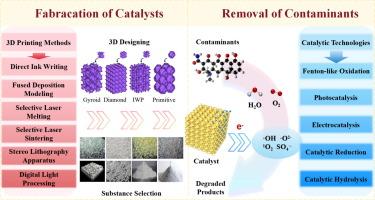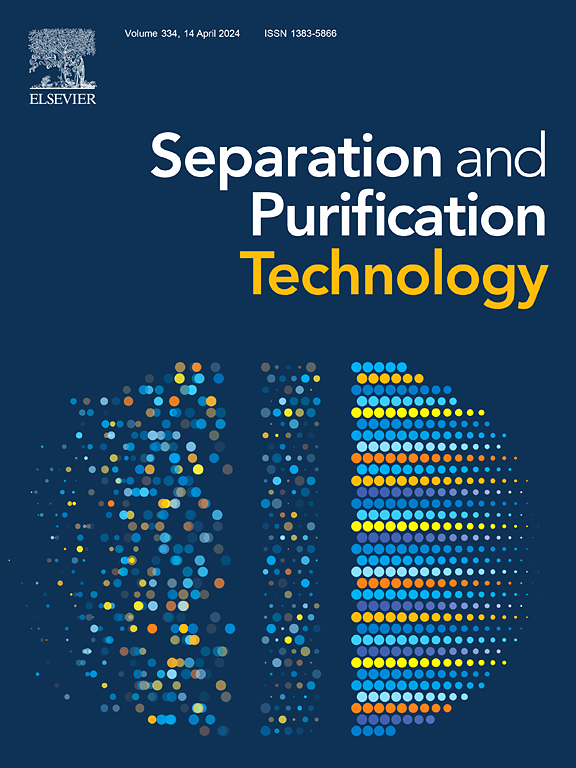Revolutionizing catalytic water treatment: A critical review on the role of 3D printed catalysts
IF 8.1
1区 工程技术
Q1 ENGINEERING, CHEMICAL
引用次数: 0
Abstract
The integration of 3D printing technology into catalytic water treatment has opened new avenues for designing advanced catalysts with customized structures and functionalities. However, a comprehensive review of how 3D-printed catalysts enhance performance, stability, and efficiency across different oxidation systems remains lacking. This review addresses that gap by summarizing recent advancements in 3D-printed catalysts for advanced oxidation processes, including Fenton-like reactions, photocatalysis, and electrocatalysis. Key aspects such as material composition, structural design, and fabrication techniques are critically evaluated. Notably, 3D-printed catalysts used in Fenton-like and photocatalytic processes benefit from improved mass transfer and enhanced active site exposure, leading to more efficient pollutant degradation. Additionally, iron- and non-metallic-based catalysts, particularly those with triply periodic minimal surface (TPMS) structures, demonstrate superior oxidation performance. The incorporation of visible light-responsive materials such as BiVO4 and g-C3N4 further boosts catalytic activity under natural sunlight. These insights pave the way for the development of more efficient and sustainable catalysts, supporting global environmental goals and promoting the adoption of 3D printing technologies in industrial applications. These insights contribute to the development of efficient and eco-friendly catalytic systems, supporting global sustainability goals and promoting the broader adoption of 3D printing technologies in industrial water treatment applications.Despite extensive research on catalytic water treatment, a systematic evaluation of the role of 3D-printed catalysts in optimizing reaction efficiency, stability, and reusability remains lacking. This review aims to fill this gap by critically analyzing the materials, structural designs, and fabrication techniques of 3D-printed catalysts and evaluating their impact on Fenton-like oxidation, photocatalysis, and electrocatalysis.

将三维打印技术融入催化水处理为设计具有定制结构和功能的先进催化剂开辟了新途径。然而,关于三维打印催化剂如何在不同氧化体系中提高性能、稳定性和效率的全面综述仍然缺乏。本综述总结了用于高级氧化过程(包括类芬顿反应、光催化和电催化)的三维打印催化剂的最新进展,从而弥补了这一空白。文章对材料组成、结构设计和制造技术等关键方面进行了严格评估。值得注意的是,用于类芬顿反应和光催化过程的三维打印催化剂可改善传质和提高活性位点暴露,从而实现更高效的污染物降解。此外,铁基和非金属基催化剂,尤其是具有三周期最小表面(TPMS)结构的催化剂,表现出卓越的氧化性能。可见光响应材料(如 BiVO4 和 g-C3N4)的加入进一步提高了催化剂在自然阳光下的活性。这些见解为开发更高效、更可持续的催化剂铺平了道路,有助于实现全球环境目标,并促进 3D 打印技术在工业应用中的采用。尽管对催化水处理进行了广泛的研究,但仍然缺乏对 3D 打印催化剂在优化反应效率、稳定性和可重复使用性方面作用的系统评估。本综述旨在通过对三维打印催化剂的材料、结构设计和制造技术进行批判性分析,并评估其对芬顿类氧化、光催化和电催化的影响,从而填补这一空白。
本文章由计算机程序翻译,如有差异,请以英文原文为准。
求助全文
约1分钟内获得全文
求助全文
来源期刊

Separation and Purification Technology
工程技术-工程:化工
CiteScore
14.00
自引率
12.80%
发文量
2347
审稿时长
43 days
期刊介绍:
Separation and Purification Technology is a premier journal committed to sharing innovative methods for separation and purification in chemical and environmental engineering, encompassing both homogeneous solutions and heterogeneous mixtures. Our scope includes the separation and/or purification of liquids, vapors, and gases, as well as carbon capture and separation techniques. However, it's important to note that methods solely intended for analytical purposes are not within the scope of the journal. Additionally, disciplines such as soil science, polymer science, and metallurgy fall outside the purview of Separation and Purification Technology. Join us in advancing the field of separation and purification methods for sustainable solutions in chemical and environmental engineering.
 求助内容:
求助内容: 应助结果提醒方式:
应助结果提醒方式:


